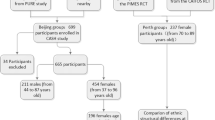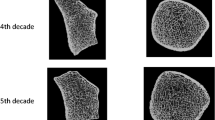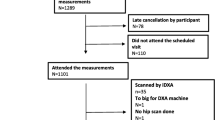Summary
Bone strength is a function of both bone mass and its geometric distribution, a factor that is obscured in the conventional bone mineral analysis. Structural geometry is particularly important in areas such as the femoral neck that are exposed to bending loadsin vivo. Here we present results of a study examining age changes in the structural geometry of the female femoral neck derived from dual photon absorptiometry (DPA) data. In a previous study, differences in the aging patterns of males and females over the entire adult age range were demonstrated. In that study, only males showed “compensatory” geometric restructuring of the femoral neck which tended to offset loss of bone mineral with age. In the present study, femoral neck structural properties from 1044 women were examined for aging trends before and after the approximate age of menopause (50 years). Women in the premenopausal age range showed a 4% decline per decade in femoral neck BMD, but no change in the femoral neck cross-sectional moment of inertia (CSMI). This aging pattern is similar to that of males in our earlier study, and in both cases resulted in little or no increase in femoral neck bending stresses. After age 50, however, women show a more rapid decline in femoral neck BMD (7% per decade) accompanied by a decline in CSMI of 5% per decade. These changes result in increases in femoral neck stresses of 4–12% per decade due to the apparent lack of compensatory restructuring to offset the loss of bone mineral. These results shed further light on the age-related mechanisms underlying sex differences in fracture incidence among the elderly. They also argue for the routine use of such structural analyses in any study of age-related osteopenia or the effects of therapeutic intervention on this condition.
Similar content being viewed by others
References
Burstein AH, Reilly DT, Martens M (1976) Aging of bone tissue: mechanical properties. J Bone Joint Surg 58A:82–86
Yamada H (1970) Strength of biologic materials. Evans FG (ed) Williams and Wilkins, Baltimore
Wall JC, Chatterji SK, Jeffery JW (1979) Age-related changes in the density and tensile strength of human femoral cortical bone. Calcif Tissue Int 27:105–108
Beck TJ, Ruff CB, Scott WW Jr, Plato CC, Tobin JD, Quan CA (1992) Sex differences in geometry of the femoral neck with aging: a structural analysis of bone mineral data. Calcif Tissue Int 50:24–29
Smith RW, Walker RR (1964) Femoral expansion in aging women: implications for osteoporosis and fractures. Science 145:156–157
Martin RB, Atkinson PJ (1977) Age- and sex-related changes in the structure and strength of the human femoral shaft. J Biomech 10:223–231
Yeater RA, Martin RB (1984) Senile osteoporosis. Postgrad Med 75:147–163
Ruff CB, Hayes WC (1982) Subperiosteal expansion and cortical remodeling of the human femur and tibia with aging. Science 217:945–948
Ruff CB, Hayes WC (1988) Sex differences in age-related remodeling of the femur and tibia. J Orthop Res 6:886–896
Martin RB, Pickett JC, Zinaich S (1980) Studies of skeletal remodelling in ageing men. Clin Orthop 149:268–282
Beck TJ, Ruff CB, Warden KE, Scott WW Jr, Rao GU (1990) Predicting femoral neck strength from bone mineral data: a structural approach. Invest Radiol 25:6–18
Rohlmann A, Mossner U, Kobel R (1992) Finite-element analyses and experimental investigation of stresses in a femur. J Biomed Engr 4:241–246
Riggs BL, Wahner HW, Seeman E, Offord KP, Dunn WL, Mazess RB, Johnson KA, Melton LJ III (1986) Changes in bone mineral density of the proximal femur and spine with aging. Differences between the postmenopausal and senile osteoporosis syndromes. J Clin Invest 70:716–723
Mazess RB, Barden HS, Drinka PJ, Bauwens SF, Orwoll ES, Bell NH (1990) Influence of age and body weight on spine and femur bone mineral density in U.S. white men. J Bone Miner Res 5:645–652
Faulkner KG, Gluer CC, Palermo L, Black D, Genant HK, Cummings SR Study of osteoporosis research group 1992: geometric measurements from dual X-ray absorptiometry scans predict hip fracture. J Bone Miner Res 7(suppl. 1):117
Author information
Authors and Affiliations
Rights and permissions
About this article
Cite this article
Beck, T.J., Ruff, C.B. & Bissessur, K. Age-related changes in female femoral neck geometry: Implications for bone strength. Calcif Tissue Int 53 (Suppl 1), S41–S46 (1993). https://doi.org/10.1007/BF01673401
Received:
Accepted:
Issue Date:
DOI: https://doi.org/10.1007/BF01673401




